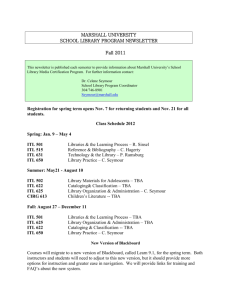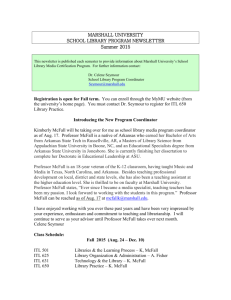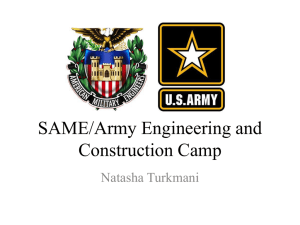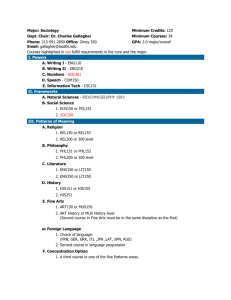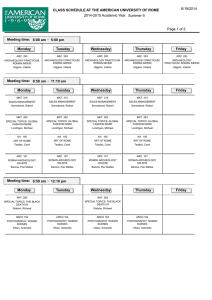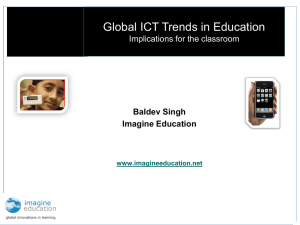Wisconsin State Standards in English Language Arts
advertisement
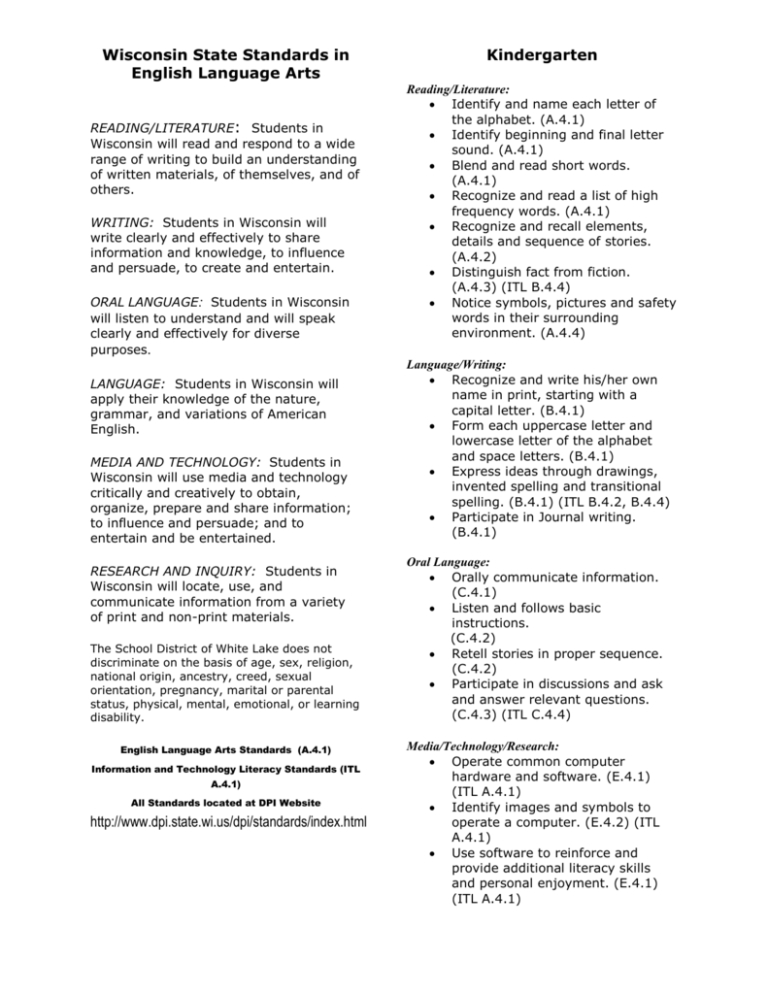
Wisconsin State Standards in English Language Arts READING/LITERATURE: Students in Wisconsin will read and respond to a wide range of writing to build an understanding of written materials, of themselves, and of others. WRITING: Students in Wisconsin will write clearly and effectively to share information and knowledge, to influence and persuade, to create and entertain. ORAL LANGUAGE: Students in Wisconsin will listen to understand and will speak clearly and effectively for diverse purposes. LANGUAGE: Students in Wisconsin will apply their knowledge of the nature, grammar, and variations of American English. MEDIA AND TECHNOLOGY: Students in Wisconsin will use media and technology critically and creatively to obtain, organize, prepare and share information; to influence and persuade; and to entertain and be entertained. RESEARCH AND INQUIRY: Students in Wisconsin will locate, use, and communicate information from a variety of print and non-print materials. The School District of White Lake does not discriminate on the basis of age, sex, religion, national origin, ancestry, creed, sexual orientation, pregnancy, marital or parental status, physical, mental, emotional, or learning disability. English Language Arts Standards (A.4.1) Information and Technology Literacy Standards (ITL A.4.1) All Standards located at DPI Website http://www.dpi.state.wi.us/dpi/standards/index.html Kindergarten Reading/Literature: Identify and name each letter of the alphabet. (A.4.1) Identify beginning and final letter sound. (A.4.1) Blend and read short words. (A.4.1) Recognize and read a list of high frequency words. (A.4.1) Recognize and recall elements, details and sequence of stories. (A.4.2) Distinguish fact from fiction. (A.4.3) (ITL B.4.4) Notice symbols, pictures and safety words in their surrounding environment. (A.4.4) Language/Writing: Recognize and write his/her own name in print, starting with a capital letter. (B.4.1) Form each uppercase letter and lowercase letter of the alphabet and space letters. (B.4.1) Express ideas through drawings, invented spelling and transitional spelling. (B.4.1) (ITL B.4.2, B.4.4) Participate in Journal writing. (B.4.1) Oral Language: Orally communicate information. (C.4.1) Listen and follows basic instructions. (C.4.2) Retell stories in proper sequence. (C.4.2) Participate in discussions and ask and answer relevant questions. (C.4.3) (ITL C.4.4) Media/Technology/Research: Operate common computer hardware and software. (E.4.1) (ITL A.4.1) Identify images and symbols to operate a computer. (E.4.2) (ITL A.4.1) Use software to reinforce and provide additional literacy skills and personal enjoyment. (E.4.1) (ITL A.4.1) First Grade Reading/Literature: Develop and apply reading strategies. (rereading, finding context clues, phonics, applying knowledge of letter – sound relationships and word and sentence structure) (A.4.1) (B.4.6) Examine known phrases and structures in materials to unlock meaning of unfamiliar words. (A.4.1) (ITL B.4.6) Use letter/sound relationships as an aid to infer meaning of unfamiliar words. (A.4.1) (ITL B.4.6) Show comprehension by summarizing events through retelling of story, identifying characters, plot and setting and using illustrations. (A.4.1) (ITL B.4.6) Read age appropriate material with fluency and accuracy. (A.4.1) (ITL C.4.3) Develop an appreciation for literature by selecting a variety of materials to read. (A.4.1) (ITL C.4.1.) Recognize various literacy formats and distinguished the difference between the formats. (A.4.2) (ITL A.4.2) Writing: Create writing in response to reading and life experiences. (B.4.1) (ITL B.4.7) Use pen/paper and computer to compose. (B.4.1) (ITL B.4.7) Write for various audiences. (B.4.1) (ITL B.4.7) Write, revise and rewrite clear, organized copies of writing using appropriate grammar and mechanics after conferring with teacher. (B.4.2) (ITL C.4.4) Demonstrate a knowledge of formal English language including nouns, pronouns and adverbs. (B.4.2) Learn to capitalize proper nouns titles and initial words of sentences. (B.4.2) Understand and demonstrate when to use punctuation marks and conjunctions. (B.4.2) Differentiate between a statement, exclamation, and question. (B.4.2) Oral Language: Communicate information orally making proper eye contact, using proper volume, rate, and articulation. (C.4.1) (ITL 4.8) Read play parts effectively. (C.4.1) Participate in choral and group readings. (C.4.1) Tell the difference between fact and fiction. (C.4.1) (ITL B.4.4) Retell a story properly retelling key points of the story. (C.4.2) Participate in class discussions and respond with comments appropriately. (C.4.3) (ITL D.4.1) Language: Develop their own vocabulary of words and phrases. (D.4.1) Know what a root word is and use that knowledge to convey meaning of words. (D.4.1) Use appropriately common figures of speech. (D.4.1) Media and Technology: Know names of basic computer parts. (E.4.1) Operate age-appropriate computer software. (E.4.1) (ITL A.4.1) Second Grade Reading/Literature: Use word recognition clues such as phonics and word structure to decode words. (A.4.1) Comprehend reading using strategies such as: prior knowledge, rereading, finding context clues, making predictions, and establishing purpose. (A.4.1) (ITL.B.4.6) Read aloud with age appropriate fluency, accuracy and expression. (A.4.1) (ITL.C.4.3) Recall details of story such as sequence, main idea, character, plot, and setting. (A.4.2) (ITL.B.4.4) Distinguish fiction from non-fiction. (A.4.3) (ITL.B.4.4) Read, interpret and analyze literature. (A.4.3) (ITL.B.4.6) Read to acquire information. (A.4.4) (ITL.C.4.1) Language/Writing: Plan, revise, edit and publish clear and effective writing. (B.4.2) (ITL.A.4.3) Use word order and punctuation marks to distinguish statements, questions, exclamations and commands. (B.4.3) Use a variety of writing techniques, including pencil and paper, and computers. (B.4.1) Begin learning upper and lower case cursive writing. (B.4.3) Understand and use parts of speech effectively, including nouns, pronouns, verbs, adjectives and adverbs. (B.4.3) Write complete sentences. (B.4.3) (ITL.A.4.3) Spell frequently used words correctly. (B.4.3) Oral Language: Read aloud effectively from previously read material. (C.4.1) Perform group readings, dramatic readings and presentations. (C.4.1) Retell stories in proper sequence. (C.4.2) Communicate information in an organized manner. (C.4.2) Demonstrate oral communications using eye contact, tone, volume, rate and articulation. (C.4.3) Media/Technology/Research: Operate common computer hardware and software. (E.4.1) (ITL.A.4.1, A.4.2) Use basic word processing for creative writing. (E.4.1) (ITL.A.4.2) Conduct research on self-selected or assigned topics. (F.4.1) (ITL.A.4.3) Access information using electronic and printed information. (E.4.1) (ITL.A.4.3, B.4.1, B.4.3) Third Grade Reading and Literature: Use effective reading strategies to achieve their purposes in reading Use reading strategies in order to achieve their purposes in reading. (A.4.1) Apply word recognition skills using strategies including rereading, finding context clues, knowledge of letter-sound relationships and word structures. (A.4.1) Infer the meaning of unfamiliar words by using context clues. (A.4.1) Use phonemic skills as an aid to pronouncing and understanding unfamiliar words. (A.4.1) Develop reading comprehension by using strategies such as prior knowledge, establishing purpose, rereading, making predictions, and adjusting reading rate according to purpose and difficulty. (A.4.1) Read aloud with age-appropriate fluency, accuracy, and expression. (A.4.1) Identify organizational features of texts, such as headings, and paragraphs, to improve understanding. (A.4.1) Identify a purpose for reading, such as to gain information, author’s opinion, or to appreciate literature. (A.4.1) Read, interpret and critically analyze literature. Recall details of story structure, such as sequence of events, character, plot, and setting. (A.4.2) Draw upon a variety of reading materials, including fairy tales, fables, and narratives from the U.S. and other cultures, when relating prior knowledge and experience. (A.4.2) Summarize ideas drawn from stories and identifying cause and effect relationships. (A.4.2) Read and discuss literary and nonliterary texts in order to understand human experience. Draw upon a variety of general knowledge about the world’s familiarity. (A.4.3)(ITL A.4.2) Summarize main ideas from literature and other print and nonprint sources. (A.4.3)(ITL B4.2) Distinguish fiction from nonfiction, fact from fantasy (A.4.3)(ITL B4.4) Select a variety of materials to read for discovery, appreciation, and enjoyment. (A.4.3)(ITL B.4.2) Read to acquire information Summarize key details of informational texts, connecting new information to prior knowledge. (A.4.4)(ITL B4.1) Identify a topic of interest, then seek information by investigating available text resources. (A.4.4) (ITL B4.1) Distinguish between facts in documents, narratives, charts, maps tables, and other information sources. (A.4.4)(ITL B4.1) Writing: Create or produce writing to communicate with different audiences for a variety of purposes Write paragraphs, stories, directions and simple reports that give facts with sequenced events. (B.4.1) Write complete sentences. (B.4.1) Write sentences in response to reading, friendly letters, and life experiences. (B.4.1) Write in a variety of situations using strategies, such as revision and use of reference materials. (B.4.1)(ITL A.4.2) Plan, revise, edit, and publish clear and effective writing Produce rough drafts, and finished pieces, that demonstrate an ability to organize ideas and revise the content. (B.4.2)(ITL A.4.3) Given a written assignment to be completed in a limited amount of time, produce a paragraph or story. (B.4.2) Understand the function of various forms, structures, and punctuation marks of standard American English and use them appropriately in communications. Understand and use parts of speech, including nouns, pronouns and adjectives. (B.4.3) Use principles of agreement related to number, gender and tense. (B4.3) Capitalize proper nouns, titles, and initial word of sentences. (B.4.3) Use commas correctly to punctuate words in a list. (B.4.3) Spell frequently used words correctly. (B.4.3) Use word order and punctuation marks to distinguish statement, question, exclamations and commands. (B.4.3) Oral Language: Orally communicate information, opinions, and ideas effectively to different audiences for a variety of purposes. Read aloud from previously read material. (C.4.1) Present fictional stories that recount events to small audiences. (C.4.1) Participate in group readings, such as choral reading. (C.4.1) Perform dramatic readings, and presentations. (C.4.1) Distinguish between fact and opinion. (C4.1) Demonstrate oral reading criteria, including eye contact, projection, rate and articulation. (C.4.1) Listen to and comprehend oral communications Follow basic directions. (C4.2) (ITL A.4.1) Identify and summarize key points of a story or discussion. (C.4.2) Retell stories and reports of events in sequence (C.4.2) Follow sequence in plot, predict outcomes, and draw conclusions. (C.4.2) Recall the content of stories after hearing them, relate the content to prior knowledge, and answer questions about the stories. (C.4.2) Distinguish nonfiction from fantasy, and fact from opinion. (C.4.2) (ITL B.4.4) Develop a use of word structures and forms, such as suffixes, prefixes, root words, homonyms, antonyms, synonyms and word analogies. (C.4.2) Participate effectively in discussion Volunteer relevant information, ask and answer questions directly. (C.4.3) Ask for clarification and explanation of unfamiliar words and ideas. (C.4.3) Summarize information used in discussions. (C.4.3) Language: Develop their vocabulary of words, phrases, and idioms as a means of improving communication. Consult glossaries, dictionaries, encyclopedias, and other resources to find and compare definitions, and to spell words correctly. (D.4.1)(ITLA.4.2) Use their knowledge of roots, prefixes, and suffixes to interpret the meaning of words. (D.4.1) Identify some of the common figures of speech and use them appropriately. (D.4.1) Recognize and interpret various uses and adaptations of language in social, cultural, regional and professional situations, and learn to be flexible and responsive in their use of English. Become aware of various styles and purposes of oral and written language. (D.4.2) Describe and give examples of variations in American English that appear in different social, cultural, and regional environments. (D.4.2) Media and Technology: Use computers to acquire, organize, and communicate information. Operate common computer hardware and software. (E.4.1)(ITLA.4.1) Attempt basic word-processing programs. (E.4.1)(ITL A.4.3) Begin to create, store and retrieve electronic files. (E.4.1)(ITL A.4.2) Begin to access information using electronic reference resources, such as encyclopedias. (E.4.1) (ITLA.4.2) Make informed judgments about media and products Recognize some basic propaganda techniques. (E.4.1)(ITL B.4.7) Demonstrate a working knowledge of media production and distribution Make distinctions between messages presented on radio, television and in print. (E.4.4) Recognize how messages are adjusted for different audiences (E.4.4)(ITL B.4.4, C.4.3) Identify sales approaches aimed at children. (E.4.4) Analyze and edit work as appropriate to audience and purpose Provide feedback to peers about the content, organization, and overall effect of media work. (E.4.5)(ITL A.4.6) Research and Inquiry: Conduct brief research on assigned topics, and communicate their findings. (F.4.1)(ITL A.4.2) Attempt to research a topic, by developing initial questions, and deciding the focus of a topic to gather information. (F.4.1) (ITL B.4.3) Fourth Grade Reading/Literature: Read aloud with age-appropriate fluency, accuracy and expression. (A.4.1) (ITL C 4.3) Recognize and recall elements of story structure. (A 4.2) Apply phonics skills to decode unfamiliar words. (A 4.1) (ITL B4.6) Identify reading purposes: information, viewpoint, and interest. (A 4.1, A 4.2) (ITL C 4.1, C 4.2, C 4.3) Use reading comprehension strategies effectively. (A 4.1, A4.3, A4.4) Language/Writing: Demonstrate standard English grammar, usage, mechanics, and spelling. (B 4.3, D 4.1) Identify parts of sentence and use the parts of speech effectively. (B 4.3, D 4.2) Create and produce writing to communicate with different audiences for a variety of purposes (B 4.1, D 4.2)(ITL A 4.3) Plan, revise, edit, and publish clear and effective writing. (B 4.2 D 4.2) (ITL B 4.7, A 4.3) Consult dictionaries, thesauri, and other resources when writing. (B 4.2, D 4.1)(ITL A 4.2) Listening/Speaking: Perform dramatic readings and presentations. (C 4.1)(ITL B 4.7) Orally communicate information effectively using eye contact, volume, articulation, and projection. (C 4.3) Participate effectively in discussions. (C 4.3) Analyze and evaluate oral presentations by self and others. (C 4.1, C 4.3)(ITL B 4.8) Listen to and comprehend oral instructions. (C 4.4) Media/Technology/Research: Conduct research by identifying, locating, exploring, and effectively using multiple sources of information. (E 4.1) Use computers to acquire, organize, analyze, and communicate information. (E 4.1) (ITL A 4.2) Create a simple media/multi-media presentation. (E 4.5) Use basic word processing, graphics, and drawing programs. (E 4.3)(ITL A 4.1) Practice keyboarding skills. (E 4.1) (ITL A 4.1) Fifth Grade Reading/Literature: Read independently daily. (A 8.1) Discuss a story in large groups. (A 8.2) Discuss how characters deal with problems. (A 8.2)(ITL C 8.2) Support and defend an author’s and personal viewpoints. (A 8.2) (ITL B 8.4) Demonstrate comprehension by completing written materials. (A 8.1)(ITL C 8.2) Language/Writing: Demonstrate standard English grammar, mechanics, usage, spelling, and parts of sentences. (B 8.1,B 8.2, B 8.3)(ITL B 8.4) Use the five components of the writing process: prewriting, writing, self-editing, peer-editing, and teacher editing. (B 8.2) Create and produce writing samples: persuasive, narrative, descriptive, and letter writing. (B 8.1, D 8.1)(ITL B 8.5) Use print/non-print resources to connect language, geography, culture, and society. (B 8.1) (ITL B 8.4) Expand vocabulary. (B 8.3) Listening/Speaking: Read orally with a partner. (C 8.1, C 8.2, C 8.3) Participate effectively in discussions. (C 8.3)(ITL B 8.3) Media/Technology/Research: Use computers and other electronic media to acquire, organize, and communicate information. (F8.1) (ITL B 8.3) Sixth Grade Reading/Literature: Read and identify a variety of literature. (A 8.3)(ITL B 8.2) Identify, analyze, and summarize story components: theme, characters, setting, plot and point of view. (A 8.2) Use word recognition strategies for definition, structural analysis, phonics, and context clues. (A 8.1) Use literature to predict, infer, judge, and draw conclusions. (A 8.2) Language/Writing: Create and produce writing samples: persuasive, narrative, descriptive, and letter writing. (B 8.1) Demonstrate use of the writing process: prewriting, drafting, revising, editing, submitting the final draft and/or publishing. (B 8.2, B 8.3) Demonstrate standard English grammar, mechanics, usage, spelling, and parts of sentence. (B 8.1, B 8.2, B 8.3, D 8.1) (ITL B 8.3) Continue to build vocabulary. (B 8.1, B 8.3) Utilize parts of speech effectively. (B 8.2) Listening/Speaking: Create oral presentations. (C 8.1, C 8.2, C 8.3) Participate in discussions and presentations as developing speakers and listeners. (C 8.1, C 8.2, C 8.3)(ITL A 8.3) Use note-taking strategies to organize and summarize classroom information. (C8.3) Media/Technology/Research: Access and utilize multiple sources of information relevant to a topic. (E 8.1) Use computers and other electronic media to acquire, organize, analyze, and communicate information. (E 8.4)(ITL A 8.3) Cite source of research material. (E 8.1)
